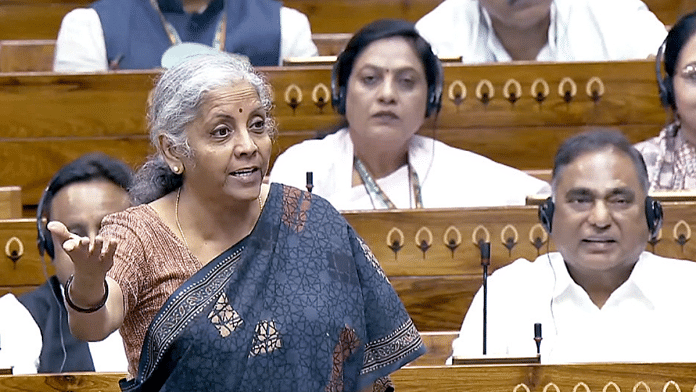New Delhi: The Economic Survey of 2023-24, tabled today in the Parliament by Finance Minister Nirmala Sitharaman, maintains that coal will meet the majority of India’s energy demand for the coming decades. The fossil fuel which currently makes up 70 percent of India’s total power generation, is expected to have a “significant role” in India’s energy demand, which will grow by 2 to 2.5 times by 2047.
The section on India’s response to climate change also pointed out the major strides made by the country in the expansion of renewable energy capacity. Specifically, the survey mentioned how on 30 April this year, India achieved 82.4 GW capacity of solar energy. The text, formulated every year by the Chief Economic Adviser to the Government of India, summarised other achievements, challenges, and goals of India’s energy transition.
“Despite being one of the fastest-growing economies in the World, India’s annual per capita carbon emission is only about one-third of the global average,” said the survey. It laid out India’s major achievements in the emissions reduction and energy transition sphere, despite pursuing its developmental goals.
The survey also referred to the India-specific hurdles of phasing out fossil fuels. Resource dependence on ‘hostile’ nations for solar panels, and grid and storage-based problems of renewable energy deployment were some challenges it mentioned. The survey also pointed out the fiscal impacts of phasing out coal power plants as well as subsidising electric vehicles and renewable energy generation in the country.
Pre-achieved targets, need for international finance
The text reinforces India’s net-zero emissions target of 2070, while outlining the estimated investment required to achieve it — $1.4 trillion, or $28 billion every year. Additionally, the report states that 83 percent of India’s green finance in 2020 came from domestic sources. It points out that there is a “substantial funding gap” in India’s climate finance which can only be met through diverse international sources.
However, despite the lack of enough international funding, India has managed to achieve a large number of its targets in its nationally determined contributions submitted to the United Nations Framework Convention on Climate Change (UNFCCC). The survey mentions how non-fossil fuel sources already make up 45 percent of India’s total installed capacity, a target achieved six years in advance.
The rate of growth of emissions from 2005 to 2019 as compared to the growth of GDP also reduced by 33 percent, thus significantly reducing the emissions intensity of our GDP. Additionally, the survey said that India is also on track to meet the carbon sink requirements of 2.5-3 billion tonnes by 2030, due to its increasing tree cover.
With regards to renewable energy, the survey explained that there needs to be an ‘orderly’ transition to a mix of energy sources, which includes hydro, solar, wind and green hydrogen. It referred to India’s advancement in each of these sectors, especially bringing up the recent viability gap funding for offshore wind energy. The survey explained that India is also looking to invest in clean coal technologies, to reduce the direct greenhouse gas emissions from thermal power plants.
Balance development and climate change
However, keeping India’s development goals in mind, the survey also pointed out that there are multiple challenges to the round-the-clock delivery of electricity from renewable sources. Also, it said that in the pursuit of renewable energy, India’s dependence on petroleum imports should not be replaced by dependence on solar photovoltaic (PV) panel imports. Given that most solar PV imports are from China, India’s geopolitical relations also play a role in deciding the deployment of renewable energy sources.
Finally, the survey talked about India having a balanced response to climate change and focusing on reducing poverty and inequality at the same time. It criticised the fact that globally carbon emissions reduction has become the top concern for all economic policies, and development has been downgraded.
“Emulating policy practices of other nations may be neither feasible nor desirable, for solutions may not emerge from approaches and places that created the problems in the first place,” said the survey.
It was referring to countries like the UK, Germany and Japan that have either postponed or not yet decided their policies for fossil-fuel phase-out. In this context, the survey also called it a ‘comedy’ that developed nations are imposing carbon taxes on imports while themselves “ramping up energy demand like never before.”
(Edited by Zinnia Ray)






